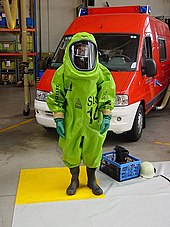Chemical protective suit
A chemical protective suit (CSA) is personal protective equipment that completely isolates the wearer from his environment so that he can work in a radiologically, chemically or bacteriologically contaminated environment. He comes z. B. used in accidents involving dangerous goods . The CSA wearer usually wears a compressed air breathing apparatus on their back to provide breathing air . A contamination protection suit is usually used to decontaminate the CSA troops .
commitment
Due to the high physical and psychological stress, the working time for the CSA is limited to 20 to a maximum of 25 minutes. Add to this the time it takes to decontaminate the carrier. In order to reduce the temperature load, especially in summer temperatures, cooling vests can be worn underneath or a ventilation system with tubes in the arms and legs can be used in a suit. The air required for this is usually taken from the breathing air circuit and thus reduces the breathing air supply when using z. B. a compressed air breathing apparatus. Another limiting influence is the limited resistance to the various chemicals.
The CSA is not resistant to all substances. Before each use, the resistance list provided by the manufacturer should be compared with the existing hazardous substance . It should also heat radiation and as the escape of gases possible icing be avoided by cold. Just like sharp edges, this can damage the material and thus contaminate the carrier. To protect against mechanical damage, an additional pair of protective gloves can be worn over the gloves integrated in the CSA, which, however, severely limit the wearer's ability to manipulate.
to form
In Germany there are different types according to the trade association rules for safety and health at work No. 189:
- Type 1 (1a, 1b and 1c) are gas, liquid and dust tight
- Types 2 and 3 are liquid, spray and dust tight
- Type 4 spray and dust tight
- Type 5 dustproof
- Type 6 restricted against liquid chemicals
Type 1 : gas-tight full protective suits , divided into:
- Type 1a: with breathing air carried inside , for example by means of a self-contained compressed air breathing apparatus ,
- Type 1b: with external breathing air supply. As a rule, this is also a compressed air breathing apparatus, but this protective suit can also be supplied with a hose or used with a suitable breathing filter .
- Type 1c: suit with compressed air hose supply (freeflow), e.g. B. used in laboratories.
Type 2 : were not gas-tight protective suits , with the revision of DIN EN 943-1: 2015-11 no longer standardized as such.
In fire brigades in Germany , the CSA belongs to body protection form 3 according to fire brigade service regulation 500. There types 1a and 1b are used, which are classified according to DIN EN 943-2 in type 1a-ET and type 1b-ET "for emergency teams" .
It should be noted that type 1a should not be operated with regeneration devices , as the heat exchange of the device can no longer be guaranteed. With type 1b, on the other hand, if the suit is contaminated, the entire breathing apparatus is also contaminated; Furthermore, it is generally not possible to determine with certainty during an operation whether the hoses on the breathing apparatus are resistant to the chemicals encountered. On the other hand, this type has the advantage that, in the event of persistent or unknown contamination, the person can be supplied with new breathing air without breaking the individual protection.
Type 1a is very common in fire brigades, type 1b can be found, for example, in the standard loading of NBC reconnaissance vehicles, in specialized hazardous goods trains , in the armed forces , in shipping and in industry.
The CSF and CMF designs, both of which belong to type 1a, are specially designed for use by fire brigades.
- CSF
- C SA with S layer disc for F your resist, here is independent of the CSA contained breathing apparatus is worn with mask under the CSA
- CMF
- C SA-incorporated M aske for F your resist, here integrated in the CSA mask is directly connected to an internal SCBA.
In Austria, chemical protective suits correspond to protection level III.
Web links
- BGR 189: Use of protective clothing
- FwDV 500 - units in ABC use. Federal Office for Civil Protection and Disaster Assistance, January 2012, accessed on February 12, 2020 .
- Plant fire brigade of the Technical University of Munich: Chemical protective suits with external air supply (PDF; 2.8 MB)


